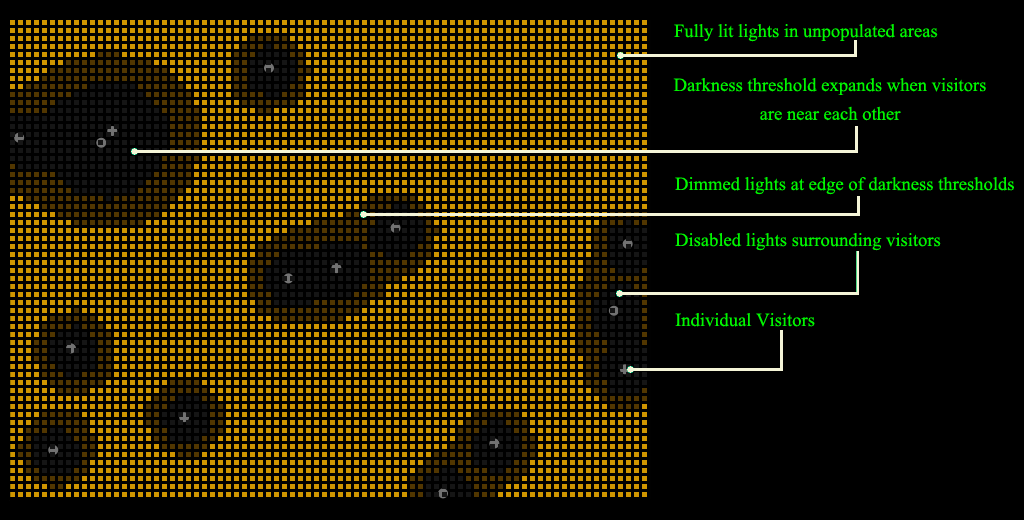User:Tamas Bates/Research/Alone: Difference between revisions
Tamas Bates (talk | contribs) (Created page with "File:Tb_r1_desc.png") |
Tamas Bates (talk | contribs) No edit summary |
||
| Line 1: | Line 1: | ||
[[File:Tb_r1_desc.png]] | [[File:Tb_r1_desc.png|frame|''Overview -- image data taken from a software simulation of the room'']] | ||
==A room which reacts to the presence of visitors.== | |||
Are we more comfortable alone in the light, or together in the dark? | |||
The entire room is lit by a large array of lights attached to or hung from the ceiling. From the outside, the room should appear bright and inviting. | |||
To minimize diffuse light from the ceiling, the floors and walls are black. There are no (open or exposed) windows. | |||
Visitors are only able to enter the room one at a time (each person must step completely inside the room before the next person enters). As soon as a visitor enters the room, the lights directly above them in the array go dark, so each person in the room stands in their own darkened space. As they move through the room, the darkness follows them--the lights above each visitor are always dark, but will re-light as soon as nobody is standing below them. | |||
If two or more visitors approach each other, the radius in which lights above them are darkened will increase in proportion to the number of adjacent visitors. | |||
In this way, when visitors gather near each other they will find the room to be darker, and the room will be at its brightest when all visitors are as far from each other as possible. | |||
==Practical Notes and Thoughts== | |||
Due to the fluid nature of the lighting conditions in the room, tracking visitors will likely need to be handled with infrared cameras. Visitors should be discouraged from wearing hats or reflective clothing if possible. Depending on how successful tracking is with IR cameras alone, it may be necessary to paint a pattern on the floor or to use a 3D camera (e.g. Kinect). | |||
The tracking data from the cameras will be processed by a computer which will generate a map of all lights affected by the current position of the visitors. Treating each visitor as the source point for a metaball is done fairly cheaply, and allows for nice blending between dark regions when visitors step near each other. Adjusting the affected radius of lights is also straightforward by simply modifying the "strength" of individuals when they get too close to each other. | |||
The lights can be driven by one or more (depending on the size of the room and density of the array) microcontrollers. Software running on the main processing machine will send instructions to the controllers when any lights need to be disabled/re-enabled. | |||
Revision as of 00:22, 11 November 2013
A room which reacts to the presence of visitors.
Are we more comfortable alone in the light, or together in the dark?
The entire room is lit by a large array of lights attached to or hung from the ceiling. From the outside, the room should appear bright and inviting. To minimize diffuse light from the ceiling, the floors and walls are black. There are no (open or exposed) windows.
Visitors are only able to enter the room one at a time (each person must step completely inside the room before the next person enters). As soon as a visitor enters the room, the lights directly above them in the array go dark, so each person in the room stands in their own darkened space. As they move through the room, the darkness follows them--the lights above each visitor are always dark, but will re-light as soon as nobody is standing below them.
If two or more visitors approach each other, the radius in which lights above them are darkened will increase in proportion to the number of adjacent visitors. In this way, when visitors gather near each other they will find the room to be darker, and the room will be at its brightest when all visitors are as far from each other as possible.
Practical Notes and Thoughts
Due to the fluid nature of the lighting conditions in the room, tracking visitors will likely need to be handled with infrared cameras. Visitors should be discouraged from wearing hats or reflective clothing if possible. Depending on how successful tracking is with IR cameras alone, it may be necessary to paint a pattern on the floor or to use a 3D camera (e.g. Kinect).
The tracking data from the cameras will be processed by a computer which will generate a map of all lights affected by the current position of the visitors. Treating each visitor as the source point for a metaball is done fairly cheaply, and allows for nice blending between dark regions when visitors step near each other. Adjusting the affected radius of lights is also straightforward by simply modifying the "strength" of individuals when they get too close to each other.
The lights can be driven by one or more (depending on the size of the room and density of the array) microcontrollers. Software running on the main processing machine will send instructions to the controllers when any lights need to be disabled/re-enabled.

